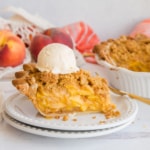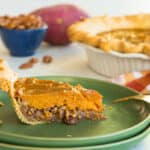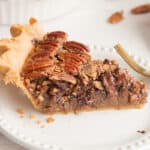Crème Brûlée Pie is a spin on the traditional crème brûlée dessert that bakes a vanilla infuse egg custard in a flaky pastry shell before topping it with a crunchy shell of torched sugar. This crème brûlée pie recipe has all the textures you want in a dessert: a flaky crust, a creamy element, and a sweet crunch.
*This post was first published in June 2018. I’ve updated it to make a 9-inch pie and updated the images and article.*
What Is Crème Brûlée Pie?
A crème brûlée pie combines the popular French egg custard and comforting pie. The custardy filling is then topped with white sugar that’s brûléed (torched) until it’s quickly melted and caramelized. The caramelized sugar cools rock hard, which gives crème brûlée that shell that so many people love to whack.
This pie recipe is a custardy dessert and old-fashioned pie in one sweet treat.
Where Does Crème Brûlée Come From?
Crème brûlée (pronounced crehm broo-LAY) is a classic French dessert whose name translates to “burned cream.” Not a very appealing name, but that’s also not an accurate description.
The dessert’s base is a custard made of egg yolks and cream sweetened with sugar. It is often flavored simply with vanilla, though you can find it made with many other things like chocolate, orange, and even lavender. The “burnt” part of its title comes from the caramelizing of the sugar topping, added after the custard has been baked and cooled.
You know crème brûlée from every high-end restaurant you’ve ever been to. What’s funny about this dessert is that, though it’s served in those fancy joints, it’s one of the cheapest and easiest desserts to make. They like jacking up the price because of all those grave, circumflex, and acute accent marks hanging over its name.
Two signs of a properly made crème brûlée are the cracking sound of the hardened caramelized sugar shell and the creamy pudding beneath.
What Are The Ingredients In A Crème Brûlée Pie?
To make creme brûlée pie, you need 8-10 ounces of pie dough, granulated sugar, egg yolks, vanilla bean paste (or vanilla extract), kosher salt, and heavy cream. Reserve 2 or 3 egg whites for the sugared garnishes if you plan to make any.
You will use a 9-inch pie tin (plate), a saucier to heat the cream, an electric hand mixer or whisk, and a rolling pin.
I’ll talk more about the garnish ingredients and equipment a little later.
What Type Of Dough Is Best For Crème Brûlée Pie?
A Mealy Pie Dough, or pâte brisée, is the best type of dough to bake custard pies, like this crème brûlée pie, in.
Blind baking the pie dough jump starts baking the shell without the risk of burning the filling inside. It also helps eliminate soggy bottoms due to not baking long enough (or baking under liquids).
Roll the pie dough out into an 11-inch circle. Carefully transfer it to the 9-inch pie plate and flute the edges of the dough in a decorative pattern. Use the tines of a fork to pierce venting holes in the bottom of the pie shell. Refrigerate the pie shell for 15-20 minutes to allow those edges time to set up.
How Long Does It Take To Blind-Bake Pie Dough?
While the shell is firming up, preheat an oven to 425°F (218°C).
Place a sheet of aluminum foil inside the cavity of the chilled pie shell and weigh it down with 2 pounds of dried beans or ceramic pie weights.
Now, if your pie plate is ceramic or glass, let it warm up to prevent it from exploding in the searingly hot oven. Ten minutes is long enough to take the chill off of it. If your pie plate is metal, you can slide it onto the oven rack after filling the foil liner with the beans.
The beans keep the dough from puffing up and distorting as it bakes. The foil helps conduct the heat while separating the beans (or weights) from the pie dough. Remember those holes you poked in the dough earlier? They also help prevent bubbles in the dough.
Blind bake the pie shell for 20 minutes.
Remove the pie plate from the oven after 20 minutes and allow it to cool for 5 minutes. Reduce the oven’s temperature to 350°F (177°C).
Lift out the foil liner with the weights and allow the pie crust to cool for 20 minutes. Dried beans and pie weights can be reused, so save them once they’ve cooled.
You can blind-bake pie shells up to 2 months ahead, then freeze the pie shell after allowing it to cool. Once frozen solid, wrap it carefully in plastic film and a layer of foil and store it in the freezer for up to 2 months. You don’t need to thaw it when you’re ready to use it; unwrap it and fill it.
How Do I Make Crème Brûlée Custard?
In a 1 or 2-quart saucepan, bring the heavy cream, vanilla bean paste, and salt up to a steaming point over medium heat. Adding the salt to the cream helps to dissolve it faster. Keep an eye on the cream. You only want it to steam, not even come up to a simmer.
While the cream is heating up, add the egg yolks and sugar to a medium-size mixing bowl. Using an electric hand mixer, or just your grit and gumption, beat the egg yolks and sugar together vigorously until they are lemony-yellow in appearance and very thick.
To make the crème brûlée custard filling, bring the heavy cream, vanilla bean paste, and salt to a steaming point over medium heat in a 2-quart heavy saucepan. Don’t allow the heavy cream to simmer, or it will scorch on the bottom.
While the cream is heating up, whisk egg yolks and sugar together in a medium bowl. Use an electric hand mixer, or just your grit and gumption, and beat the egg yolks and sugar together vigorously until they are lemony-yellow in appearance and very thick.
The beaters will leave behind a thick ribbon when lifted from the egg mixture’s surface when properly whisked.
Whisk the hot cream into the egg mixture in a slow, steady trickle. The eggs will curdle if you add the cream too fast, so add the cream slowly.
How Long Do I Need To Bake The Pie?
Pour the custard into the pie shell after the cream is whisked in.
Carefully slide the pie into the oven, taking care not to spill it. Bake the crème brûlée pie for 30-35 minutes in the preheated oven until the center is just barely jiggly.
How Far Ahead Can I Bake The Pie?
You should bake the crème brûlée pie a day or two ahead to give it time to chill and firm up.
Carefully remove the pie from the oven after it’s done baking. Allow the pie to cool to room temperature, then cover it with plastic wrap. Don’t press the plastic onto the surface of the crème brûlée as it will take some of the custard with it when you remove it.
Refrigerate the crème brûlée pie for 12 hours (or overnight) to set it.
How Do I Create The Brûlée Topping?
You can use granulated sugar or superfine (caster) sugar to brûlée.
Remove the pie from the refrigerator and sprinkle the sugar in an even layer over the top of the pie. Ensure there are no clumps of sugar, or it won’t brûlée properly. Use a butane torch to melt and caramelize the sugar topping. The sugar will bubble and change from yellow to golden brown to dark brown in seconds, so be conservative in how long you torch each section.
Once the sugar is a deep amber color, turn the torch off and allow it to set (and harden) for 1 minute.
Can I Brûlée If I Don’t Have A Kitchen Torch?
You can brûlée the crème in your oven under the broiler if you don’t have a butane kitchen torch. Protect the edges of the pie by covering them with aluminum foil first.
Set the broiler to high, and slide the sugar-topped pie under it. You want it to be six inches away from the broiler. Broil the pie until the sugar bubbles, then carefully remove it from the oven. The sugar will continue to brown as it sits.
This isn’t my favorite method because it also heats the pie underneath, but it’ll work in a pinch.
How Do I Garnish Crème Brûlée Pie?
Now, I’m not saying you must go all out with your crème brûlée pie’s garnish. But you are now a part of my merry band of misfits, and we do extra. The crème brûlée pie is ready to dig into right now, but why not up the ante with a cute garnish? You can sugar berries- cranberries, strawberries, blackberries, etc.- and herbs a day or two ahead, so they’re dried and ready to go onto the pie when it’s brûléed. Just try to avoid doing this on a humid or rainy day. The moisture in the air will keep them from drying properly.
Take the egg whites leftover from separating your eggs for the custard. Put the egg whites in a small mixing bowl and beat them until smooth with a fork.
Drop 3 or 4 berries into the bowl of whites and use the fork to toss them around. Lift the berries out of the whites with the fork and sprinkle sugar over them. Next, transfer the sugared berries to a cooling rack.
Use a pastry brush to brush both sides of sage leaves and coat them in sugar. Brush the rosemary stems with egg whites and dip them in the sugar. Shake off excess sugar from each item before transferring them to the cooling rack.
Allow these to dry for at least 2 hours, but overnight is best. Store them uncovered so they dry hard. I would store them in an airtight container containing food-safe silica gels.
How Do I Serve The Pie?
To serve the crème brûlée pie, strike the sugar crust with it with the heel of your knife to break it.
Once you get through the shell, cut it as you would any other pie.
You can serve this with fresh berries if they’re in season. You can also serve this on its own if you’re not doing the sugared fruits and herbs. It needs no other garnish or topping, though whipped cream is a popular accompaniment with my family.
How Do I Store Crème Brûlée Pie?
The best way to store crème brûlée pie is uncovered in the refrigerator. Because this is a custard pie, it needs to be refrigerated so it’s safe to eat.
The downside of this brûlée topping is that it loses its crunchiness after an extended period in the fridge.
Since the rock-hard sugar starts to soften in the fridge, crème brûlée pie is best enjoyed within 2 days of brûléeing it. You might have caramel goo-topped custard pie instead of crème brûlée goodness if you store it longer. It’ll still taste amazing but may also be a bit messier.
Can I Freeze This Pie?
The finished crème brûlée pie is not freezer-friendly. You can freeze the pie after chilling it but before brûléeing it. Just wrap the pie carefully in plastic wrap and freeze it for up to 2 months. Thaw it in the fridge, then top it with sugar and brûlée.
This remix of the classic dessert will wow you and your crew. Serve this decadent Crème Brûlée Pie at your next holiday celebration, special occasion, or family dinner. Let me know what you think of this recipe in the comments below. Don’t forget to share it with your world, too!

Crème Brûlée Pie
at Sense & EdibilityEquipment
- 9-inch pie plate
- rolling pin
- butane torch
Ingredients
- 1 half-portion (8 ounces or 227 grams) Mealy Pie Dough
- 2 cups (500 milliliters) heavy cream
- 1 tablespoon (15 milliliters) vanilla bean paste
- 1/4 teaspoon kosher salt
- 6 large egg yolks (3 whites reserved for the garnish, optional)
- 3/4 cup sugar
Caramelized Sugar Topping
- 2 1/2 tablespoons (31 grams) granulated sugar
Optional Garnish
- 15 fresh cranberries
- 6 sprigs rosemary
- 3 sprigs sage
- 3 large egg whites (reserved from separating the yolks above)
- 1 cup granulated sugar
Instructions
Blind Bake the Pie Shell
- Roll the pie dough out into an 11-inch circle. Transfer this circle of dough to a 9-inch pie plate. Prick holes in the bottom of the pie dough using the tines of a fork. Refrigerate the pie shell for 15-20 minutes to allow the dough to firm up.
- While the shell is firming up, move your oven rack to the middle position and preheat your oven to 425°F (218°C).Once the chilling time for your pie shell is done, place a sheet of aluminum foil inside the cavity and weigh it down with 2 pounds of dried beans or ceramic pie weights. Bake the pie shell for 20 minutes.
- After 20 minutes, remove the pie plate from the oven and allow it to cool down for 5 minutes. Reduce the oven's temperature to 350°F (177°C).After 5 minutes, remove the foil liner with the weights and allow both the weights and pie shell to cool while you prepare the custard.
Make the Egg Custard
- In a 1 or 2-quart saucepan, stir together the heavy cream, vanilla bean paste, and salt.Bring this cream mixture up to a steaming point over medium heat, stirring occasionally to avoid scalding the cream. Don't allow the cream to come to a simmer. You only want steam to rise off the surface.
- While the cream is heating up, add the egg yolks and sugar to a medium-size mixing bowl. Using an electric hand mixer, or a whisk, beat the egg yolks and sugar together vigorously until they are lemony-yellow in appearance and very thick. The beaters (or whisk) should leave behind a thick ribbon when lifted from the surface of the egg mixture.
- Add the warm cream to the egg mixture in a slow and steady trickle, stirring constantly with a whisk. If you add it too fast, the eggs will curdle. The slower the better. Once the cream is added to the egg mixture, pour the custard into the blind-baked pie shell.
Bake the Crème Brûlée Pie
- Carefully slide the pie into the preheated oven. Bake the pie for 30-35 minutes or until the center is just barely jiggly.
Cool, then Chill the Pie Completely
- Once the pie is barely jiggly in the center, carefully remove it from the oven. Allow the pie to cool to room temperature, then cover it lightly with plastic wrap. Refrigerate the pie for 12 hours (or overnight) to allow it to firm up completely.
Brûlée the Pie (See Notes if You Don't Have a Butane Torch)
- Sprinkle 2 1/2 tablespoons (31 grams) of sugar evenly over the surface of the chilled pie. Make sure the sugar is spread evenly and not clumped up. Use a butane torch to melt and caramelize the sugar topping. The sugar will bubble and change from yellow to a golden brown to dark brown in seconds, so be conservative in how long you torch each section.
- Once the sugar is a deep amber color, turn the torch off and allow it to set (and harden) for 1 minute.
Prepare the Sugared Cranberries and Herbs Garnish (Optional and Can Be Done 2-3 Days Ahead)
- Add the whites to a small mixing bowl. Beat the egg whites with a fork until they run smooth. Keep the fork handy because you'll use it to dip your cranberries.Drop 3 or 4 cranberries into the bowl of whites and use the fork to toss them around. Lift the cranberries out of the whites with the fork and place them gently into the sugar. Sprinkle sugar over the cranberries to coat them before transferring them to a cooling rack.
- Use a pastry brush to brush both sides of sage leaves and coat them in sugar as well. Brush the rosemary stems with egg whites and dip them in the sugar. Shake off excess sugar from each item before transferring them to the cooling rack.
- Allow the cranberries, sage, and rosemary to dry for at least 2 hours, but overnight is best. Store them uncovered, so they dry hard. If you make them days ahead, store them in an airtight container with a pack of food-safe silica gels.
Decorate the Pie and Serve
- Arrange the sugared cranberries, sage, and rosemary in a half or full-wreath design on top of the sugar crust.
- To serve the crème brûlée pie, hit it with the blade of your knife to get through the sugar shell. Once you get through the shell, cut it as you would any other pie.
Notes
Tips and Techniques:
- If your pie plate is ceramic or glass, allow it warm up for 10 minutes on the countertop to take the chill off of it. This will prevent it from shattering in the hot oven. If your pie plate is metal, you can slide it into the preheated oven right after you fill the foil liner with the beans.
- The beans keep the dough from puffing up and distorting as it bakes. The foil helps conduct the heat while separating the beans (or weights) from the pie dough. The holes you poked into the dough also help prevent bubbles form forming as the pie shell bakes.
- Both dried beans and weights can be reused, so be sure to save them once they've cooled.
- Don't press the plastic onto the surface of the crème brûlée as it will mar the top. Just drape it over the pie crust and the pie plate.
- Try to avoid sugaring the cranberries and herbs on a humid or rainy day. The moisture in the air will keep them from drying properly.
- You can serve this with fresh berries if they're in season, on its own, or topped with whipped cream.
To brûlee without a butane torch:
This isn't my favorite method because it also heats the pie underneath, but it'll work in a pinch.- Protect the edges of the pie by covering them with aluminum foil, first.
- Set and oven rack so that it's 6-inches from your oven's broiler. Set the broiler to high, and slide the sugar topped pie under it.
- Broil the pie just until the sugar begins to bubble, then carefully remove it from the oven. The sugar will continue to brown as it sits.
Make-Ahead Instructions:
- For blind-baking the pie shell:
- Freeze the pie shell, uncovered, after allowing it to cool (after you blind bake it).
- Once it's frozen, wrap it carefully in plastic film and a layer of foil and store it in the freezer for up to 2 months.
- When you're ready to use it, you don't even need to thaw it, Just unwrap it and fill it.
Storage and Freezer Instructions:
- Remember that this is a custard pie. As such, you need to keep refrigerated as much as possible.
- The downside of this brûlée topping is that it loses its crunchiness after an extended period in the fridge, which is up to 2 days. Enjoy it as soon as you can.
-
This pie is not freezer-friendly with the sugar topping. To freeze the pie after chilling it:
- Wrap the pie carefully in plastic film.
- Freeze the pie for up to 2 months.
- Thaw completely in the fridge, then top with the sugar before brûléeing it.
To make 4 3-inch Crème Brûlées:
- Omit the pie shell baking steps.
- Bring a pot of water to a boil, and preheat your oven to 350°F (177°C).
- Divide the custard equally between 4 3-inch ramekins. Set the ramekins in a deep roasting pan, pushing them to one end of the roasting pan.
- Pour the boiling water into the opposite end of the roasting pan. This is done to avoid splashing water into the custard. Only pour enough water to reach halfway up the sides of the ramekins.
- Carefully slide the ramekins into the center of the roasting pan, leaving at least an inch of space between each one.
- Bake the custards for 15 minutes or until set.
- Remove the pan from the oven and chill completely in the fridge.
- Brûlée as instructed above.





















I love this recipe, it’s honestly just SO good! I have a question regarding a temperature discrepancy in your post..in the recipe it says to bake the pie at 350F. In the “How long do I need to bake the pie” section it says to bake the pie with filling at 425F…which temp is correct? I’ve been doing it at 350F and it’s worked..so I will keep on with that. This pie has become the favorite dessert for my bf and I. I say this as a couple who has made numerous desserts. Thanks for the great recipe!
Hi there! You’re right! Bake it at 350°F (180°C). I forgot to edit the decrease in temperature in the updated post. Thanks for the heads up and for leaving a comment to help me fix that!
INCREDIBLE recipe!! Never heard of a crème brûlée pie until I had limited ingredients on hand and needed to make a dessert! So glad I found this. Will add this to my go-to’s for fun desserts ❤️
Enjoy, Justine!
Marta, Marta! Just love reading the descriptions of all the things you make!! The part about the price tag for a crème brûlée to match the number of fancy accent marks, is priceless! Hilariously true.
It’s funny ’cause it’s true, Magalys! Welcome!
This pie was delicious. I had a creme brûlée pie at a restaurant that made me look for a recipe to make. This was spot on and beautiful. My guests really love the creamy texture and the crunchy crust. Great dessert. Will def make again.
That makes me so happy, Karen. Thank you!